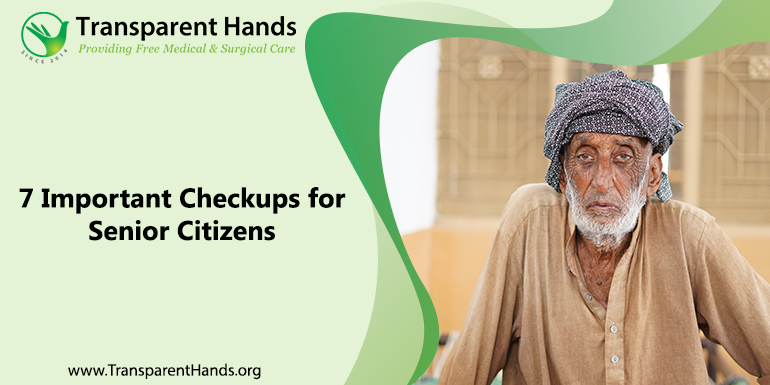7 Important Checkups for Senior Citizens

Old age is a risk factor for a number of medical conditions. It is highly important to undergo these 7 Important Checkups to identify these conditions at their earliest. Earlier diagnosis prevents the progression of these diseases and improves the quality of life. The seven most important check-ups for senior citizens include:
Cardiovascular Checkups
As we grow older, the blood vessels start to lose their elasticity and become stiffer and hardened. The hardened vessels present more resistance to the blood flow and increase blood pressure. Hence, the blood pressure rises and increases the risk of cardiovascular diseases for such individuals.
Therefore, it is important for senior citizens to routinely monitor their blood pressure. And if three consecutive readings are above 140/90 mmHg, immediately seek professional advice.
Lipid Profile
Old age also increases the likelihood of higher cholesterol in the blood. It is usually most common in women because of hormonal changes after menopause. Low-density lipids, also known as bad lipids, begin to rise while high-density lipids, also known as good lipids, start depleting. This can increase the risk of coronary artery disease and other cardiovascular diseases, including heart attack and stroke.
Hence, senior citizens should routinely undergo screenings and if the lipid level is not within the normal range, it’s important to seek health advice. Usually, physicians recommend changes in the diet if the levels are not too abnormal. But if they are, you would be prescribed lipid-lowering medications.
Bone Density Checkup
For people who are 25 to 50 years old, bone density remains stable as the breakdown and formation are at equilibrium. But after 50, the formation of bone slows down, and the breakdown increases which can lead to osteoporosis. It weakens that bone and puts the patients at higher risk of fracture.
Again, it is most common for women as estrogen, a hormone, plays an important role in bone development. After menopause, the hormone levels in the blood reduce, which affects the strength of bones. Hence, it is important to undergo routine screening for bone density.
The most common tests used to identify bone-related disorders are ALP and Dexa Scans.
Diabetes Screening
Old age is a risk factor for diabetes as well. Diabetes Mellitus Type 2 is the most common one and it often goes unnoticed. Unlike Type 1 DM, symptoms of Type 2 DM are not that severe and patients may not even know it until they undergo a medical screening. In addition to impairing the body’s ability to heal itself, DM can also lead to eye-related issues, neuropathy, and vascular disease. Therefore, it is extremely important to identify the disease at its earliest and start managing it.
Although BSR (blood sugar random) can give you indications about the disease, HbA1c is required to make a proper diagnosis. Hence, senior citizens should check their HbA1c levels at least once every four months.
Some patients may experience symptoms such as:
- Increased hunger
- Increased thirst
- Increased frequency of urination
- Impaired healing ability
Mental and Cognitive Checkups
Alzheimer’s disease and Dementia are very common in the older population. These conditions are associated with forgetfulness, changes in mood, and the inability to learn new things. Although there are currently no treatments to permanently cure these conditions, early diagnosis can slow down the progression.
Neurologists have devised several scales to test the mental and cognitive functions of the body. Senior citizens must visit their physicians routinely for the early detection of these diseases. Symptoms of these conditions include:
- Increased memory loss and confusion
- Problems with reading, writing, and working with numbers
- Difficulty in organizing thoughts
- Decreased attention span
- Inability to cope with novel situations
Eye examination
Eyesight can also become compromised as our body ages. Some of the most common conditions associated with old age include glaucoma, dry eyes, temporal arteritis, cataracts and macular degeneration. Almost all of these conditions are associated with loss in eyesight.
Impaired eyesight can cause great difficulty in carrying out daily chores and tasks. Fortunately, most of these medical conditions are curable with medications and certain procedures. But it is important not to ignore these problems and routinely undergo eye examinations.
Fall Risk Assessment
Older populations are at higher risk of falling down. Increased fall risk can lead to fractures which can take a lot of time to heal as the body’s ability to heal itself is also compromised. Hip fracture is the most common one, which can lead to long-term hospitalization and may require surgical treatment. Due to old age, the body takes a lot of time to heal and the hospitalization time increases as well.
It is very important to undergo fall risk assessment and take precautionary measures if patients are at higher risk. It is a routine procedure at most geriatric healthcare centers.
Bottom Line – 7 Important Checkups
Old age comes with a number of medical problems but most of these conditions can be prevented with a few precautions. It is important to undergo routine medical evaluations to detect these conditions at their early stages. Doing so can halt the progression of the disease at an early stage and improve the overall quality of life.
Transparent Hands has helped hundreds of geriatric patients since 2014. Not only do we set up free medical camps where they can visit for checkups, but also provide them with surgical and medical treatments. We function with total transparency and provide detail of each case on our website. Donate to this cause now.










Leave a Reply